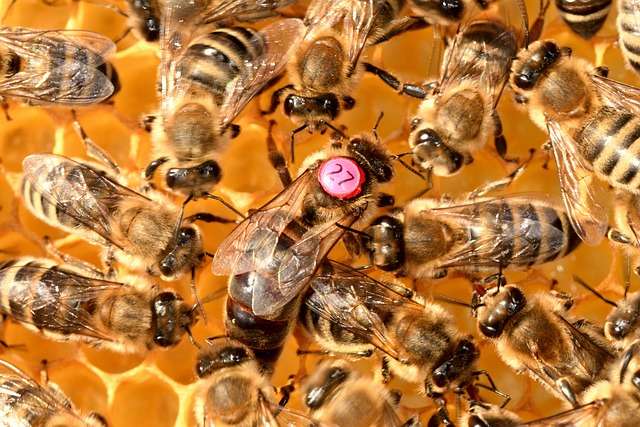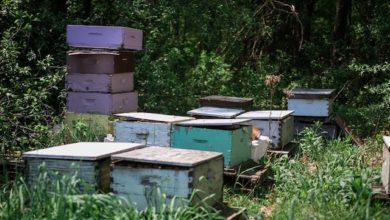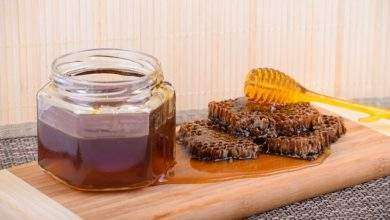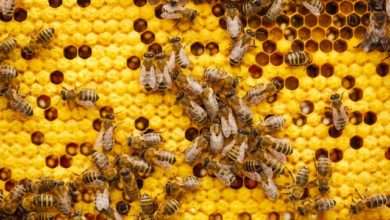Uses for a Queen Marker

Beekeeping is an extremely important trade. Not only do honeybees provide us with honey, wax, and other lovely products; they also keep the environment lush with plentiful pollination. One of the most vital aspects of beekeeping is the management of the hive and its queen. To aid beekeepers in this task, there is an essential tool known as the queen marker.
What is a Queen Marker?
A queen marker is a tool used in beekeeping to identify queens for inspection and re-queening. It is designed to mark the feathers or body of the queen bee with contrasting color, making her easier to locate in the hive.
The marker is typically a small piece of colored plastic that has an adhesive backing. It can be purchased in a variety of shapes and colors. Generally, the color red is used since it stands out and contrasts strongly against the dark coloring of queen bees.
When Do You Use a Queen Marker?
Queen markers are primarily used in queen rearing or for the process of splitting up a beehive. They are also very important for keeping track of the queen’s age. As queens age, they appear larger and are easier to identify. Markers help beekeepers quickly locate the queen and determine her age.
In queen rearing, they’re used to mark newly-emerged queens by putting a small droplet of paint on the thorax or wing of the queen bee. This is a helpful way to ensure that the queen is not lost in the hive. The marker also helps beekeepers track the virility and fertility of a queen.

Queen markers can also be used to inspect a hive and identify eggs, larvae, and pupae. By placing small bits of colored thread or other small markers in these areas, beekeepers can quickly assess the health of the hive.
Marking the Queen Honeybee
The queen bee is the most important bee in a colony. She is responsible for the survival and productivity of the hive. A marked queen bee makes it easier for beekeepers to identify their queens, assess the health of their colonies and track the age of the queen. In this chapter, we will explore the uses for a queen marker and the steps to marking the queen bee.
- Explanation of why it is important to mark the queen bee
Marking the queen bee makes it easier for beekeepers to locate her in the hive, especially in large colonies with thousands of bees. It also enables them to identify if a queen has been replaced, a necessary measure for ensuring the longevity of a colony.
Knowing the age of the queen is crucial in identifying the source of any problems that arise in the hive, as older queens are less productive than younger ones.
- Steps to marking the queen bee with a queen marker
Before marking the queen bee, a beekeeper needs to determine if the queen is healthy and capable of laying eggs. This is done by inspecting the brood pattern, which should be uniform and cover most of the frames.
Once the queen is located, beekeepers can use a queen marker to mark her thorax.
The process involves:
- Placing the queen on a clean surface or using a queen catcher.
- Shake the queen marker to ensure that the ink is evenly distributed.
- Gently grasp the queen behind the head with a pair of tweezers.
- Use the queen marker to apply a small dot of ink to the thorax of the queen bee.
- Release the queen back into the colony.
- Different colors available for queen markers and their significance.
Queen markers come in different colors that can indicate the age of the queen or the year in which she was marked. The standard colors are:
- White (year ending in 1 or 6)
- Yellow (year ending in 2 or 7)
- Red (year ending in 3 or 8)
- Green (year ending in 4 or 9)
- Blue (year ending in 5 or )
Moreover, beekeepers can also use customized colors to mark their queen bees based on their preferences or significant events. Regardless of the color chosen, it is essential to update the queen’s mark every one to two years to ensure the accuracy of the queen’s age.
Determining Queen Bee Age
One of the most important aspects of beekeeping is ensuring the health and longevity of the queen bee. The queen bee is responsible for producing all the bees in a colony and maintaining the overall productivity of the hive. As such, it is important to know the age of the queen bee so that appropriate measures can be taken to ensure her well-being. This is where a queen marker comes in handy.
To determine the age of the queen bee using a queen marker, beekeepers need to know the color-coding system used for queen marking (listed above).
Knowing the age of the queen bee allows beekeepers to anticipate the timing of important events in the hive, such as swarm season or honey production. For example, if the queen bee is nearing the end of her productivity, the beekeeper can begin the process of replacing her in order to ensure that the hive remains strong and healthy.
Queen Re-introduction
Queen re-introduction is a process where beekeepers introduce a new queen bee into a beehive to replace a weak or dead queen. The process involves marking the queen bee using different colors, typically according to the year of her introduction. The queen marker is used to identify the queen bee, and prevent her from getting lost among the other bees in the hive.
- Explanation of how to use queen marker during queen re-introduction
During queen re-introduction, beekeepers must mark the queen bee to help identify and track her movements. Queen markers are small, numbered plastic or metal discs that come in different colors for different years.
The beekeeper catches the queen and carefully applies the marker to her thorax, between the wings. This process enables the beekeeper to track the queen and monitor her behavior, ensuring that she is laying eggs and the hive is healthy.
- Benefits of queen re-introduction
Queen re-introduction has numerous benefits for beekeepers. Firstly, it ensures that the hive is productive, healthy, and functional, thus preventing colony collapse.
Additionally, through the marking process, beekeepers can keep track of the health and behavior of the queen bee and ensure that the hive remains stable and productive. Also, it prevents swarming, a process where bees leave the hive with the old queen to start a new colony.
Marking Frames
This tip comes from a lecture given by Master Beekeeper Bob Binney.
In addition to marking your queens, the queen marker can also be used to mark your individual frames, to keep a record of their age. Many beekeepers will discard frames of drawn comb after a certain age (for example 5 years).
Simply put a dot or two on the top of the frame, according to the color chart.

When Should You Not Use a Queen Marker?
It’s important to note that queen markers can be detrimental to a hive’s health if overused or if the marker is too large. They should never be used when the queen is in the middle of laying eggs, as it can disrupt her laying cycle and potentially put the entire hive at risk.
Also, the markers should never be used on other bees in the hive as this could cause them to be confused or even killed.
Lastly, queen markers should not be used to indicate the health of a queen. They should only be used as a tool to identify and provide quick assessments. For accurate assessment of a queen’s health, a more thorough inspection from a professional beekeeper is required.
Conclusion
Queen markers are an invaluable tool for beekeepers who need to monitor the health and productivity of their hives. They serve a range of purposes, from queen rearing to marking eggs and larvae for inspection. However, these markers should never be used on a queen in the middle of laying eggs, nor should they be used to indicate the health of the queen. When used properly, queen markers are an effective way to keep track of a hive’s queen.
FAQ
Will marking the queen harm her or affect the hive?
- No, marking the queen does not harm her or affect the hive. In fact, it can be a helpful tool for beekeepers to identify and manage their hives. However, it’s important to handle the queen gently and avoid stressing her out during the marking process.
How often should I mark the queen?
- Once a queen has been marked, the color should last for the queen’s lifetime (which can be up to several years). However, if the mark becomes faded or difficult to see, you can re-mark the queen with a fresh dot.
Can I use any marker to mark the queen?
- No, not all markers are safe or suitable for use on queen bees. It’s important to use a marker that is specifically designed for beekeeping, as other markers may contain harmful chemicals or be too difficult to see on the queen’s body.
How do I remove a mark from a queen bee?
- If you need to remove a mark from a queen bee (for example, if the mark has become faded or confusing), you can gently wipe it off with a soft cloth or a Q-tip dipped in rubbing alcohol.
How can I tell if a queen has been marked?
- If a queen has been marked, you should be able to easily see the colored dot on her thorax. This can be helpful in finding and identifying the queen during hive inspections.
Where can I purchase a Queen Marker?
- You can purchase a Queen Marker from many beekeeping supply stores or online beekeeping retailers. It’s important to choose a high-quality marker from a reputable source to ensure the safety and effectiveness of the tool.




